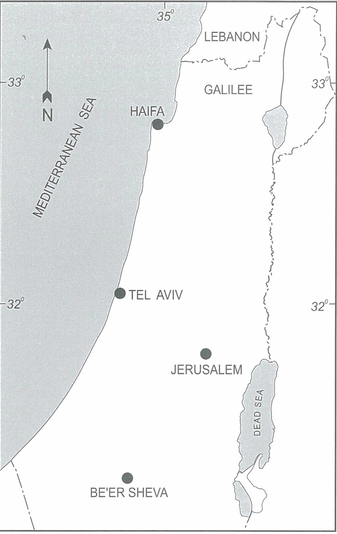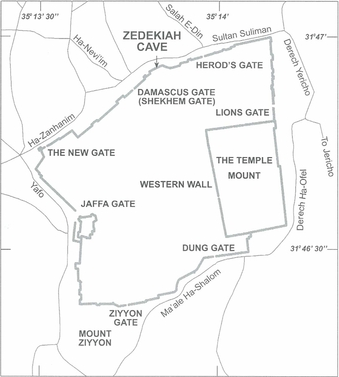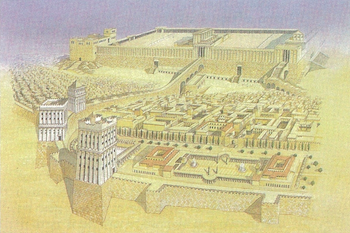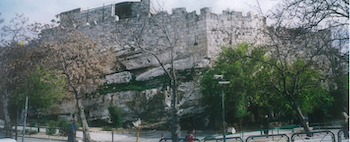By Zeev Lewy
Geological Survey of Israel
Jerusalem, Israel
March 2011
The Zedekiah Cave opens at the foot of the northern wall of the old city of Jerusalem close to the Damascus gate (Fig. 1& Fig. 2). The iron door closes over a rather small ancient entrance which leads southwards below the area built into a 230 m deep and 80-100 m wide cave divided into halls connected by tunnels. Thick quadrangular pillars offer support in the 4-15 m high ceiling attesting to a Roman quarrying style. The white limestone walls bear quarrying and carving marks left when the underground activity ended no later than the Roman or early Byzantine period. Large blocks may have been quarried during the Hasmonean time (142 B.C.E.-63 A.D.) and up to Byzantine period (638 A.D.; Safrai and Sasson, 2001) though there is no archaeological proof. A carving on one of the walls of a winged four-legged animal with a human face resembles an Assyrian sphinx. Detailed investigation discovered the use of a dentate saw-like instrument to smoothen the rock before carving, a technique known from the Second Temple period (Barkay, 1986). In the absence of additional age-indicative archaeological findings, the cave was suggested to fulfill various functions from biblical times onward. It was named Royal Cavern, King Solomon’s Quarries or the Kings’ Quarries, as well as Zedekiah Cave as if King Zedekiah, the last king of Judea, fled through it from Jerusalem to Jericho where he was captured in the summer of 587 B.C.E. by Nebuchadnezzar’s Babylonian soldiers (II Kings, 25: 5). The Zedekiah Cave was thought to be an old natural cave formed through limestone dissolution by slightly acidic rain water (karst) that was later extended into an underground quarry already during the First Temple. At that time subsurface tombs where dug in the region for wealthy and distinguished personalities (Barkay, 1997). The cave lacks any karstic chimney to the surface and has no other opening apart of the present day one. This entrance is located on a quarried wall that was part of the northern moat around the city some 16 m above the ditch floor (Barkay, 1986). Its present day position at the level of the road (Fig. 3) confused researchers as if the cave were accessible from the ground since ancient times.
Old Jerusalem was built on limestone (and dolostone) rocks which supplied its building stones. Relics of numerous biblical and younger quarries are exposed in the region questioning the need for subsurface quarrying under dangerous and hard working conditions. The single small entrance limited natural illumination and aeration farther from the entrance. The weak and unstable torch light blurred the vision of the quarrymen and hindered them from being aware of rocks detaching from the ceiling or other hazards. The fire of the many torches consumed oxygen from the damp atmosphere in the cave and added smoke. Quarrying building stones under these hard and dangerous conditions must have required significant reasons regarding the numerous quarries which operated nearby on the surface.
The quarried rock
The present day old city of Jerusalem, which comprises much of the city during the Second Temple, is built on hard limestone forming millimeter thin layers up to a few meter thick layers deposited from the ancient sea from which the Judean Mountains originated. The limestone beds are made of calcareous fragments of marine organisms such as mollusks, echinoderms, algae, and calcareous unicells which lived in the water and on or in the bottom sediment. These were cemented into hard limestone by lime dissolved in the water. Changes in the components and periodical supply of clay minerals resulted in the separation into layers which facilitated the ability to cut them into blocks in the thickness of the layer. The quarrying activity in the Zedekiah Cave followed the inclination of the layers along a certain type of limestone which forms a 3-4 m thick layer. Surprisingly, this layer consists of a rather soft and wet rock easily crushed into powder-like chalk, appearing completely useless for building stone. This, therefore, raises the question: why was this type of rock the target of underground quarrying as if it were a precious ore?
This type of limestone consists of tiny fragments of a kind of clam belonging to the group of rudists which does not live today. Most of them grew attached to the shallow sea bottom in a conical shape enlarging upward. The round opening was covered by a flattened valve which could rise to enable water and food to reach the mollusk inside. The rudists developed a vesicular conch which was thick and strong but could have been rapidly precipitated to withstand wave impact and damage by marine boring organisms. They lived during the Cretaceous period along the southern margins of the tropical and subtropical Tethys Sea and were common in the present region of Israel. Their ability to close the conch when covered by sediment or during low tide gave them an advantage over corals in the same environment. Therefore, thick rudist reef-like structures developed along the ecologically suitable shelves. The mineralogical composition of this calcareous skeleton was mainly calcite in contrast to aragonite in most other mollusks. When exposed to slightly acidic ground- or sea-water calcite, it is little affected whereas aragonite dissolves. Thereby the sea-water in between the calcareous particles became supersaturated with respect to aragonite, resulting in the precipitation of the excess lime nearby, cementing the friable sediment into hard limestone.
The rudist reef-like structures contributed their fragments to the surrounding filling the spaces in between the conches while the tiny fragments were transported beyond the “reef core” into the lagoon or the open sea. The deposition of this rudist detritus for a long period accumulated into thick complex of a rather homogenous composition lacking internal separation into individual layers. These calcitic fragments remained as loose particles and did not fuse together into a hard rock. With time, little of the calcite and associated aragonite dissolved from the slightly acidic ground water in between the tiny calcite fragments. The exposure of this wet rock to the sun evaporated the water and concentrated the dissolved lime content beyond saturation causing the precipitation of the lime in between the rudist fragments whereby they cemented to each other into a hard rock. The homogenous nature of the thick layer enabled workers to cut large blocks in different directions and shapes for which this rock-type was named by quarrymen “freestone.” These properties were known to the quarrymen of the First Temple period who dug into this soft homogenous rock-type the subsurface tombs and easily shaped their interior (e.g., Barkay, 1997). However, in quarries on the ground, only successions of hard limestone beds were quarried for building stones.
Why did the useless rock become valuable?
King Herod planned to renovate the Second Temple into an impressive construction situated on top of a high and large platform (Fig. 4) looking over the city (Ritmeyer and Ritmeyer, 1989). In order to receive the approval of the religious establishment, King Herod insisted on keeping the religious law forbidding the presence of metal tools on the Temple Mount as applied during the construction of the First Temple by King Solomon. “In the building of the house, only blocks of undressed stone direct from the quarry were used; no hammer or axe or any iron tool whatever was heard in the house while it was built” (I Kings, 6: 7). These restrictions were in the spirit of the Lord’s commandment (Exodus [Jethro] 20, 25) that a stone altar should not be built from stones that were treated by metal tools (relating metal tools to the sword as a weapon). The forbidden use of metal tools on the Temple Mount would have slowed the building process because each block would have had to be exactly shaped outside the site to fit into the construction.
The Roman advisors to King Herod were familiar with a kind of limestone in southern England (Britain) near the city of Seaton in Devon (Beer quarries) which is wet and friable in subsurface but hardens when exposed and dried. There the friable nature is due to the calcite composition of the echinoderm fragments which are the dominant constituent (Jarvis and Tocher, 1987). They probably asked the local Jewish quarrymen about a similar type of limestone that could be shaped by non-metallic tools a few days after being quarried so that building stones could be fitted one onto another on the Temple Mount under the religious restrictions. Then the building stones of the sanctuary (Holy of Holies) could be cut out by non-metallic tools in the quarry. The local quarrymen probably showed the Roman engineers the useless kind of limestone in between the hard layers in the quarries close to the city. Finding it suitable for their needs, the Romans looked for thick layers of this rock-type near the city. Based on the nature of bedding planes, they traced the suitable layer into the subsurface from where large quantities should be quarried. They detected the suitable layer some 16 m above the base of the moat along the wall of the northern wall defending the city. They piled a ramp toward the location of the layer on the wall where they opened a small entrance and thereafter started quarrying along the inclination of the 3-4 m thick layer. The layer extends along the wall for several meters which could provide more entrances to transport material and stones in and out. However, the single small entrance attests to the intelligence of the Roman advisors. They preferred a single small entrance on its operational inconvenience in order to minimize the escape of the moisture from the cave and hence prevented the rock from drying out and hardening. These special requirements complicated and endangered the quarrymen’s work but provided enormous quantities of building stones that were finally shaped on the Temple Mount when the construction began in 20 B.C.E. Part of these rocks could be shaped into decorative blocks for other constructions as well.
Conclusions
Subsurface quarrying of building stones in biblical times which formed the Zedekiah Cave in Jerusalem while numerous quarries operated nearby on the ground is explained by geological criteria and religious aspects which also date the opening of the cave as a quarry. The peculiar qualities of this rock type in subsurface facilitated its rapid quarrying in blocks of different sizes and shapes for the grandiose construction of the Second Temple by King Herod. These could be fitted to each other on the Temple Mount without using metal tools according to the religious restrictions. The combined experience of Jewish quarrymen and Roman engineers enabled them to keep the religious spirit in this holy mission and complete the monumental construction of the Second Temple in a short time (Lewy, 2005).
References
Barkay, G., 1986. “The Zedekiah Cave – The archaeological aspect.” Ariel, v. 43, 102-107
(in Hebrew).
Barkay, G., 1997. “The First-Temple period burial caves north of Damascus Gate and the date
of Jerusalem’s northern moat.” Cathedra, v. 83, 7-26 (in Hebrew).
Jarvis, I., and Tocher, B.A., 1987. Field meeting: The Cretaceous of SE Devon. Proceedings of
the Geological Association of London, v. 98, 51-66.
Lewy, Z. 2005. Short contribution: “Geological and religious factors for subsurface quarrying
that formed the Zedekiah Cave in Jerusalem, Israel.” Geoarchaeology, v. 21, 187-196.
Ritmeyer, K., and Ritmeyer, L., 1989. “Reconstructing Herod’s Temple Mount in Jerusalem.”
Biblical Archaeology Review, v. 15, 23-42.
Safrai, Z. and Sasson, A., 2001. “Quarrying and quarries in the land of Israel.” Ariel in Hebrew; English abstract), 114 pp.
Figure captions:
Fig.1: Map of Israel

Fig. 2: The location of the Zedekiah Cave at the northern wall of the city of Jerusalem.

Fig.3: Panorama of the limestone layers and the city wall in front of the Zedekiah Cave entrance at the right lower corner.

Fig.4: Reconstruction of the Temple Mount and the Second Temple in the city of Jerusalem of King Herod (by the courtesy of D. Kroyanker, Jerusalem).


Does the cave extend to "the place of the skull"and even further ? Could be where the ancients shifted their temple valuables when the Babylonians conquered Jerusalem